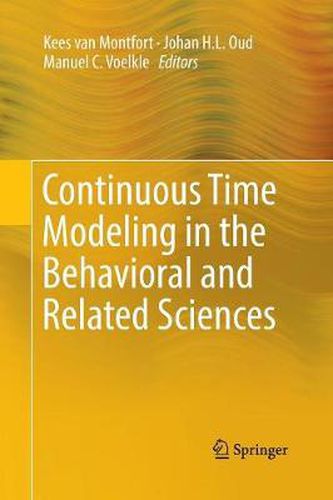Readings Newsletter
Become a Readings Member to make your shopping experience even easier.
Sign in or sign up for free!
You’re not far away from qualifying for FREE standard shipping within Australia
You’ve qualified for FREE standard shipping within Australia
The cart is loading…






This title is printed to order. This book may have been self-published. If so, we cannot guarantee the quality of the content. In the main most books will have gone through the editing process however some may not. We therefore suggest that you be aware of this before ordering this book. If in doubt check either the author or publisher’s details as we are unable to accept any returns unless they are faulty. Please contact us if you have any questions.
This unique book provides an overview of continuous time modeling in the behavioral and related sciences. It argues that the use of discrete time models for processes that are in fact evolving in continuous time produces problems that make their application in practice highly questionable. One main issue is the dependence of discrete time parameter estimates on the chosen time interval, which leads to incomparability of results across different observation intervals. Continuous time modeling by means of differential equations offers a powerful approach for studying dynamic phenomena, yet the use of this approach in the behavioral and related sciences such as psychology, sociology, economics and medicine, is still rare. This is unfortunate, because in these fields often only a few discrete time (sampled) observations are available for analysis (e.g., daily, weekly, yearly, etc.). However, as emphasized by Rex Bergstrom, the pioneer of continuous-time modeling in econometrics, neither human beings nor the economy cease to exist in between observations.
In 16 chapters, the book addresses a vast range of topics in continuous time modeling, from approaches that closely mimic traditional linear discrete time models to highly nonlinear state space modeling techniques. Each chapter describes the type of research questions and data that the approach is most suitable for, provides detailed statistical explanations of the models, and includes one or more applied examples. To allow readers to implement the various techniques directly, accompanying computer code is made available online. The book is intended as a reference work for students and scientists working with longitudinal data who have a Master’s- or early PhD-level knowledge of statistics.
$9.00 standard shipping within Australia
FREE standard shipping within Australia for orders over $100.00
Express & International shipping calculated at checkout
This title is printed to order. This book may have been self-published. If so, we cannot guarantee the quality of the content. In the main most books will have gone through the editing process however some may not. We therefore suggest that you be aware of this before ordering this book. If in doubt check either the author or publisher’s details as we are unable to accept any returns unless they are faulty. Please contact us if you have any questions.
This unique book provides an overview of continuous time modeling in the behavioral and related sciences. It argues that the use of discrete time models for processes that are in fact evolving in continuous time produces problems that make their application in practice highly questionable. One main issue is the dependence of discrete time parameter estimates on the chosen time interval, which leads to incomparability of results across different observation intervals. Continuous time modeling by means of differential equations offers a powerful approach for studying dynamic phenomena, yet the use of this approach in the behavioral and related sciences such as psychology, sociology, economics and medicine, is still rare. This is unfortunate, because in these fields often only a few discrete time (sampled) observations are available for analysis (e.g., daily, weekly, yearly, etc.). However, as emphasized by Rex Bergstrom, the pioneer of continuous-time modeling in econometrics, neither human beings nor the economy cease to exist in between observations.
In 16 chapters, the book addresses a vast range of topics in continuous time modeling, from approaches that closely mimic traditional linear discrete time models to highly nonlinear state space modeling techniques. Each chapter describes the type of research questions and data that the approach is most suitable for, provides detailed statistical explanations of the models, and includes one or more applied examples. To allow readers to implement the various techniques directly, accompanying computer code is made available online. The book is intended as a reference work for students and scientists working with longitudinal data who have a Master’s- or early PhD-level knowledge of statistics.